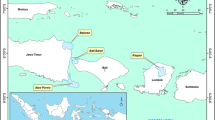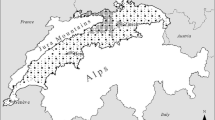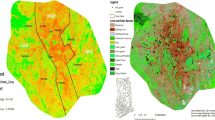Abstract
Urbanization is one of the main drivers of environmental change and can result in drastic changes to the biodiversity and composition of plant communities. The objective of the present work was to investigate whether the structure, diversity and composition of Neotropical savanna woody plant communities differ among fragments immersed in urban, peri-urban and rural environments. The study was carried out in nine Neotropical savannas with distinct levels of urbanization in the municipality of Montes Claros, state of Minas Gerais, Brazil. A total of 469 woody individuals belonging to 76 species and 30 families of plants were sampled. The most specious families were the Fabaceae with seventeen species and the Vochysiaceae with eight. The most abundant species were Myracrodruon urundeuva in urban areas, Byrsonima pachyphyla in peri-urban areas and Hymenaea stigonocarpa in rural areas. The diversity (species richness, estimated species richness and Simpson diversity index) and structure (abundance, cover and height) of the plant communities under study did not vary in response to urbanization, although species composition experienced notable changes. The urban plant communities were very distinct from the rural plant communities. Furthermore, the dominant species were very different among the urban, peri-urban and rural areas. These findings demonstrate that urbanization affects Neotropical savanna species that are susceptible to anthropization. Furthermore, among the anthropogenic pressures related to urbanization, fragmentation and isolation seem to be the most influential determinants of the composition of Neotropical savanna communities.





Similar content being viewed by others
References
Albouy C, Velez L, Coll M, Colloca F, Le Loc’h F, Mouillot D, Gravel D (2014) From projected species distribution to food-web structure under climate change. Global Change Biol 20:730–741
Almeida DS (2016) Alguns princípios de sucessão natural aplicados ao processo de recuperação. In Recuperação ambiental da Mata Atlântica. pp. 48-75
Alvares CA, Stape JL, Sentelhas, PC, Gonçalves JLM, Sparovek G (2013) Köppen’s climate classification map for Brazil. Meteorol Z 6:711–728
Araújo WS (2016) Global patterns in the structure and robustness of plant-herbivore networks. Front Biogeogr 8:1–8
Beardsley K, Throne JH, Roth NE, Gao S, McCoy MC (2009) Assessing the influence of rapid urban growth and regional policies on biological resources. Landscape Urban Planning 93:172–183
Belo NO, Pinheiro RT, Reis ES, Ricklefs RE, Braga EM (2011) Prevalence and lineage diversity of avian Haemosporidians from three distinct Cerrado habitats in Brazil. PLoS One 6:3-e17654
Brandão SSS, Silva WD (2016) Configuration of the urban space of the city of Montes Claros - MG after 1970: new centralities. Humanidades 5: 62–73
Burton ML, Samuelson LJ, Pan S (2005) Riparian woody plant diversity and forest structure along an urban-rural gradient. Urban Ecosyst 8:93–106
Calgaro HF, Buzetti S, Silva LR, Stefanini L, Montenegro de Miranda LP, de Moraes MA, Teixeira de Moraes ML (2015) Natural distribution of tree species in areas with different levels of human disturbance and its relation with chemical properties of the soil. Rev Árv 39:233–243
Carvalho PER (2003) Aroeira verdadeira. Circ Técn 82:1–16
Chao A, Chazdon RL, Colwell, RK, Shen TJ (2005) A new statistical approach for assessing similarity of species composition with incidence and abundance data. Ecol Letters 8:148–159
Christie FJ, Hochuli DF (2005) Elevated levels of herbivory in urban landscapes: are declines in tree health more than an edge effect? Ecol & Soc 10:1–10
Christie FJ, Cassis G, Hochuli DF (2010) Urbanization affects the trophic structure of arboreal arthropod communities. Urban Ecosyst 13:169–180
Colli GR, Vieira CR, Dianese JC (2020) Biodiversity and conservation of the Cerrado: recent advances and old challenges. Biodivers & Conservation 29:1465–1475
Concepción ED, Moretti M, Altermatt F, Nobis MP, Obrist MK (2015) Impacts of urbanisation on biodiversity: the role of species mobility, degree of specialisation and spatial scale. Oikos 124:1571–1582
Concepción ED, Obrist MK, Moretti M, Altermatt F, Baur B, Nobis MP (2016) Impacts of urban sprawl on species richness of plants, butterflies, gastropods and birds: not only built-up area matters. Urban Ecosyst 19:225–242
Didham RK, Tylianakis JM, Gemmell NJ, Rand TA, Ewers M (2007) Interactive effects of habitat modification and species invasion on native species decline. Trend Ecol Evol 22:489–496
Didhan RK, Lawton JH (1999) Edge structure determines the magnitude of changes in microclimate and vegetation structure in tropical forest fragments. Biotropica 31:17–30
Dolan RW, Stephens JD, Moore ME (2015) Changes in plant species composition and structure in two peri-urban nature preserves over 10 years. Amer Midland Naturalist 174:33–49
Durigan G, Ratter JA (2016) The need for a consistent fire policy for Cerrado conservation. J Appl Ecol 53:11–15
Elias F, Marimon BS, Gomes L, Forsthofer M, Abreu MF, Reis AS, Lenza E, Franczak DD, Marimon-Junior BH (2013) Resiliência de um cerradão submetido a perturbações intermediárias na transição Cerrado-Amazônia. Biotemas 26:49–62
Elmqvist T, Zipperer W, Güneralp B (2016) Urbanization, habitat loss, biodiversity decline: solution pathways to break the cycle. In Seta, Karen; Solecki, William D.; Griffith, Corrie A. (eds) Routledge handbook of urbanization and globalenvironmental change. London and New York: Routledge, pp 139–151
Flora do Brasil 2020 em construção. Jardim Botânico do Rio de Janeiro. Available at http://floradobrasil.jbrj.gov.br (Accessed 02 November 2018
Foley JA, Defries R, Asner GP, Barford C, Bonan G, Carpenter SR, Chapin FS, et al (2005) Global consequences of land use. Science 309:570–574
Françoso R, Brandão R, Nogueira CC, Salmona Y, Machado RB, Colli GR (2015) Habitat loss and the effectiveness of protected areas in the Cerrado biodiversity hotspot. Nat Conservation 13:35–40
Furley PA (1999) The nature and diversity of neotropical savanna vegetation with particular reference to the Brazilian cerrados. Glob Ecol Biogeog 8:223–241
Ganem SR, Drummond JA, Franco JLA (2013) Conservation polices and control of habitat fragmentation in the Brazilian Cerrado biome. Amb & Soc 16:99–118
Gimaret-Carpentier C, Pélissier R, Paschal JP, Houllier F (1998) Sampling strategies for the assessment of tree species diversity. J Veg Sci 9:161–172
Godefroid S, Koedam N (2007) Urban plant species patterns are highly driven by density and function of built-up areas. Land Ecol 22:1227–1239
Gomes L, Simões SGC, Nora ELD, Sousa-Neto ER, Forti MC, Ometto JPHB (2019) Agricultural expansion in the Brazilian Cerrado: increased soil and nutrient losses and decreased agricultural productivity. Land 8:1–26
Grimm NB, Faeth SH, Golubiewski NE, et al (2008) Global change and the ecology of cities. Science 319:756–60
Hammer O, Harper DAT, Ryan PD (2001) Past: paleontological statistics software package for education and data analysis. Paleontol Electronica 4:1–9
Handel SN, Saito O, Takeuchi K (2013) Restoration ecology in an urbanizing world. In Elmqvist T et al. (eds) Urbanization, biodiversity and ecosystem services: Challenges and opportunities. Springer, Dordrecht, pp 665–698
Haridassan M (2008) Nutritional adaptations of native plants of the Cerrado biome in acid soils. Braz J Pl Physiol 20:183–195
Hilbert DR, Roman LA, Koeser AK, Vogt J, van Doorn NS (2019) Urban tree mortality: a literature review. Arboric Urban Forest 45:167–200
Hoffmann WA, Franco AC (2003) Comparative growth analysis of tropical forest and savanna woody plants using phylogenetically independent contrasts. J Ecol 91:475–484
Junior HFB, Valcarcel C, Roppa C, Nettesheim FC (2011) Study of rustic species in a pasture area and in the Atlantic forest remnants in Piraí, State of Rio de Janeiro, Brazil. FLORAN 18:50–59
Laurance WF (1999) Reflections on the tropical deforestation crisis. Biol Conservation 91:109–117
Liu Z, He C, Wu J (2018) The relationship between habitat loss and fragmentation during urbanization: an empirical evaluation from 16 World Cities. PLoS ONE 11:e0154613
Lorenzi H. (1998) Árvores brasileiras: manual de identificação e cultivo de plantas arbóreas nativas do Brasil. 2nd ed. Nova Odessa, São Paulo
MacGregor-Fors I, Moralez-Pérez R, Shondube JE (2011) Does size really matter? Species–area relationships in human settlements. Diversity & Distrib 17:112–121
Marques JJGSM, Schulze DG, Curi N, Mertzaman SA (2004) Major element geochemistry and geomorphic relationships in Brazilian Cerrado soils. Geoderma 119:179–195
Marzluff JM, Bowman R, Donnelly R (2001) A historical perspective on urban bird research: trends, terms and approaches, In Marzluff, JM, Bowman R, Donelly R (eds). Avian ecology and conservation in an urbanizing world. Boston: Kluwer Academie, pp 1–17
McKinney ML (2002) Urbanization, biodiversity, and conservation. BioScience 52:883–890
McKinney ML (2006) Urbanization as a major cause of biotic homogenization. Biol Conservation 127:247–260
McKinney ML (2008) Effects of urbanization on species richness: a review of plants and animals. Urban Ecosyst 11:161–176
Morandi PS, Marimon BS, Marimon-Junior BH, Ratter JA, Feldpausch TR, Colli GR, Munhoz CBR, da Silva Júnior MC, de Souza LE, Haidar RF, Arroyo L, Murakami AA, de Góis AF, Walter BMT, Ribeiro JF, Françoso R, Elias F, de Oliveira EA, Reis SM, de Oliveira B, das Neves EC, Nogueira DS, Lima HS, de Carvalho TP, Rodrigues SA, Villarroel D, Felfili JM, Phillips OL, (2020) Tree diversity and above-ground biomass in the South America Cerrado biome and their conservation implications. Biodivers & Conservation 29:1519–1536
Moreira RG, Fernandes GW, Almada ED, Santos JC (2007) Galling insects as bioindicators of land restoration in an area of Brazilian Atlantic Forest. Lundiana 8:107–112
Myers N, Mittermeier RA, Mittermeier CG, Fonseca GAB, Kent J (2000) Biodiversity hotspots for conservation priorities. Nature 403:853–858
Nock CA, Paquette A, Follett M, Nowak DJ, Messier C (2013) Effects of urbanization on tree species functional diversity in Eastern North America. Ecosystems 16:1487–1497
Novacek MJ, Cleland EE (2001) The current biodiversity extinction event: scenarios for mitigation and recovery. Proc Nat Acad Sci USA 98:5466–5470
Pickett STA, Burch J, William B, et al (1997) A conceptual framework for the study of human ecosystems in urban areas. Urban Ecosyst 1:185–99
Pinho BX, Dattilo W, Leal IR (2017) Structural breakdown of specialized plant-herbivore interaction networks in tropical forest edges. Global Ecol Conservation 12:1–8
R Development Core Team (2015) R: A language and environment for statistical computing. R Foundation for Statistical Computing, Vienna, Austria. Available at http://www.R-project.org
Ratter JA, Ribeiro JF, Bridgewater S (1997) The brazilian cerrado vegetation and threats to its biodiversity. Ann Bot (Oxford) 80:223–230
Rezende AV, Sanquetta CR, Figueiredo Filho A (2005) Efeito do desmatamento no estabelecimento de espécies lenhosas em um cerrado sensu stricto. Floresta 35:69–88
Ribeiro JF, Walter BMT (2008) As Principais Fitofisionomias Do Bioma Cerrado. In Sano SM, Almeida SP, Ribeiro JF (eds) Ecologia e flora. Embrapa Planaltina, pp 152–212
Samways MJ (1996) Insects in the urban environment: pest pressures versus conservation concern. In Proceedings of the Second International Conference on Urban Pests. pp 129–133
Schwartz MW, Smith LM, Steel ZL (2013) Conservation investment for rare plants in urban environments. PLoS One 8:e83809
Silva JMC, Bates JM (2002) Biogeographic patterns and conservation in the South American Cerrado: a tropical savanna hotspot. BioScience 52:225–234
Simon MF, R Grether, LP de Queiroz, C Skema, RT Pennington, CE Hughes (2009) Recent assembly of the Cerrado, a Neotropical plant diversity hotspot, by in situ evolution of adaptations to fire. Proc Natl Acad Sci USA 106:20359–20364
Singh AK, Singh H, Singh JS (2018). Plant diversity in cities: call for assessment and conservation. Curr Sci 115:428–435
Souchie SF, Pinto JRR, Lenza E, Gomes L, Maracahipes-Santos L, Silvério DV (2017) Post-fire resprouting strategies of woody vegetation in the Brazilian savanna. Acta Bot Brasil 31:260–266
Staniczenko PPA, Lewis OT, Tylianakis JM, Albrecht M, Coudrain V, Klein AM, Reed-Tsochas F (2017) Predicting the effect of habitat modification on networks of interacting species. Nature Commun 8:1–10
Walker JS, Grimm NB, Briggs JM, Gries C, Dugan L (2009) Effects of urbanization on plant species diversity in central Arizona. Frontiers Ecol Environm 7:465–470
Acknowledgements
The authors thank to CAPES for the master's scholarship to first author, to Erik Wild for English revision, to Leonardo Bergamini for help in statistical analyses, to Odirlei Simões and Santos D'Angelo (in memorian) for help with the identification of plant species, to colleagues of the Laboratory of Interactions, Ecology and Biodiversity – LIEB for help with the field collections, and to Universidade Estadual de Montes Claros - Unimontes for logistical support. This research was financed by FAPEMIG (APQ-00394-18) and CNPq (423915/2018-5).
Author information
Authors and Affiliations
Corresponding author
Additional information
Publisher’s note
Springer Nature remains neutral with regard to jurisdictional claims in published maps and institutional affiliations.
Appendix
Appendix
Rights and permissions
About this article
Cite this article
Freitas, É.V.D., das Dores Magalhães Veloso, M. & de Araújo, W.S. Urbanization alters the composition, but not the diversity and structure, of Neotropical savanna woody plant communities. Folia Geobot 55, 95–108 (2020). https://doi.org/10.1007/s12224-020-09366-4
Received:
Revised:
Accepted:
Published:
Issue Date:
DOI: https://doi.org/10.1007/s12224-020-09366-4




